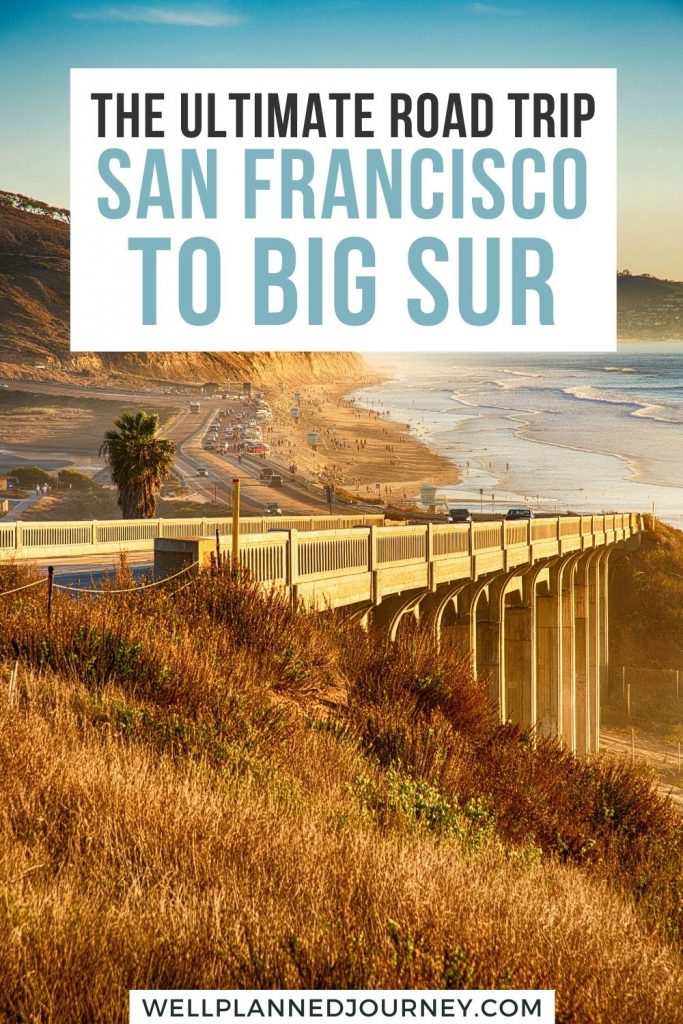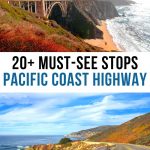Jagged mountains meet waves crashing in from the Pacific Ocean. There are few places in the world as scenic and majestic as the California coastline.
The Pacific Coast Highway is the best way to see the California coast. Starting in Mendocino County north of San Francisco, it runs 656 miles south along the California coast to San Juan Capistrano, south of Los Angeles.
One of the most scenic stretches of the Pacific Coast Highway is the route from San Francisco to Big Sur.
This guide details all the essential stops along this stretch of the coastal scenic drive, plus tips to make your scenic drive as seamless as possible.
Let’s dive in and plan your road trip along the Pacific Coast Highway!
Looking for more adventures along the California Coast? Don’t miss these posts!
- San Francisco to Redwood National Park Road Trip
- The Best California Lost Coast Road Trip
- Hiking Alamere Falls Near San Francisco
This post may contain affiliate links, where I may receive a small commission at no additional cost to you. Read more in this disclosure policy.
General Pacific Coast Highway Scenic Drive Information
- California is known for its year-round warm weather, particularly in the coastal regions. The Pacific Coast Highway is open all year with mild weather even in winter months.
- While the weather may be consistent all year, summer is the busiest time of year on the Pacific Coast Highway. If you want fewer crowds, consider visiting in off-seasons, November-March.
- The straight-through drive from San Francisco to Big Sur is 4 hours. While you could do this trip in a day, it’s best to break it up over a few days. Spend a night in Monterey or Pacific Grove. The next day you can explore Big Sur before driving on to Los Angeles or returning to San Francisco.
Important Tips for Driving from San Francisco to Big Sur
- Start in San Francisco and drive south to Big Sur. Driving the Pacific Coast Highway from north to south provides unobstructed ocean views. Driving south also keeps the pull-offs on your righthand side. This makes the driver safer, rather than cutting across oncoming traffic.
- Drive slowly and take your time. This stretch of highway is among the most jaw-dropping in the country and you won’t want to miss a thing. Avoid making firm plans at the end of your drive, like dinner reservations. You’ll want to stop at every single vista to take in the salty ocean breeze and jagged cliff edges.
- The Pacific Coast Highway is remote in some parts, meaning there’s a high likelihood you’ll lose cell service. Print out or screenshot your map and points of interest ahead of time. Download Google Maps for navigation.
- Pack a portable charger. Because you’ll be using your phone to navigate, take photos, and keep track of points of interest, you’ll want to bring a car phone charger.
- Big Sur is by far the most remote area of the Pacific Coast Highway. The only gas stations along a 50-mile stretch in Big Sur are in the town of Big Sur. Make sure you have a full tank of gas before setting out from Carmel-by-the-Sea.
- Northern California is warm by day, but cool at night. If you’ll be stopping for sunset or driving at night, make sure to bring a warm jacket as temperatures can get as low as the 40s.
Looking for more tips on what to pack for your road trip? Check out my guides on the ultimate road trip packing list and the best road trip planning tools for all my favorite gear picks and tips to make packing for your trip a breeze!
The Best Stops on the Pacific Coast Highway Between San Francisco and Big Sur
1. San Francisco
The Pacific Coast Highway passes right through the middle of San Francisco. The City by the Bay is a cultural melting pot, with Asian and Hispanic influence.
After driving across the Golden Gate Bridge, stop into Chinatown for some dim sum or grab a famous burrito in the Mission.
If you’re looking for a panoramic view of the city on a clear day, make the drive up to Twin Peaks.
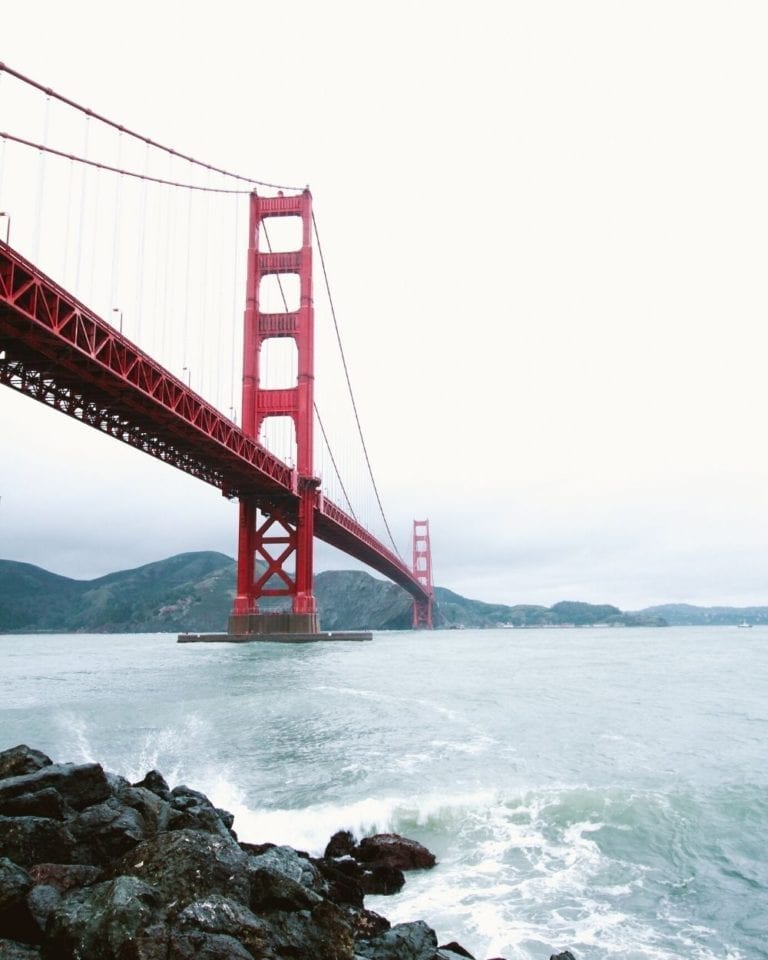
2. Devil’s Slide
Past the beach town of Pacifica, you’ll drive through a tunnel. Before the tunnel opened in 2013, motorists navigated the dangerous, rockslide-prone Devil’s Slide.
Today, this perilous section of the highway is open for hikers and bikers. Stop and stretch your legs on Devil’s Slide.
3. Half Moon Bay
This beach town is popular among tourists and surfers. The cliffside Ritz Carlton Half Moon Bay offers a lunchtime destination for big spenders.
Fill up on gas and snacks before heading further down the rugged coast.
4. Pigeon Point Lighthouse
One of the west coast’s tallest, and most photographed, lighthouses is about 20 miles south of Half Moon Bay. You can view the original Fresnal lens in the visitor center of this still-active lighthouse.
If you’re lucky, you’ll spot seals or whales in the water below.
A unique feature of this lighthouse? It has a hostel on the property featuring a cliffside hot tub for guests.
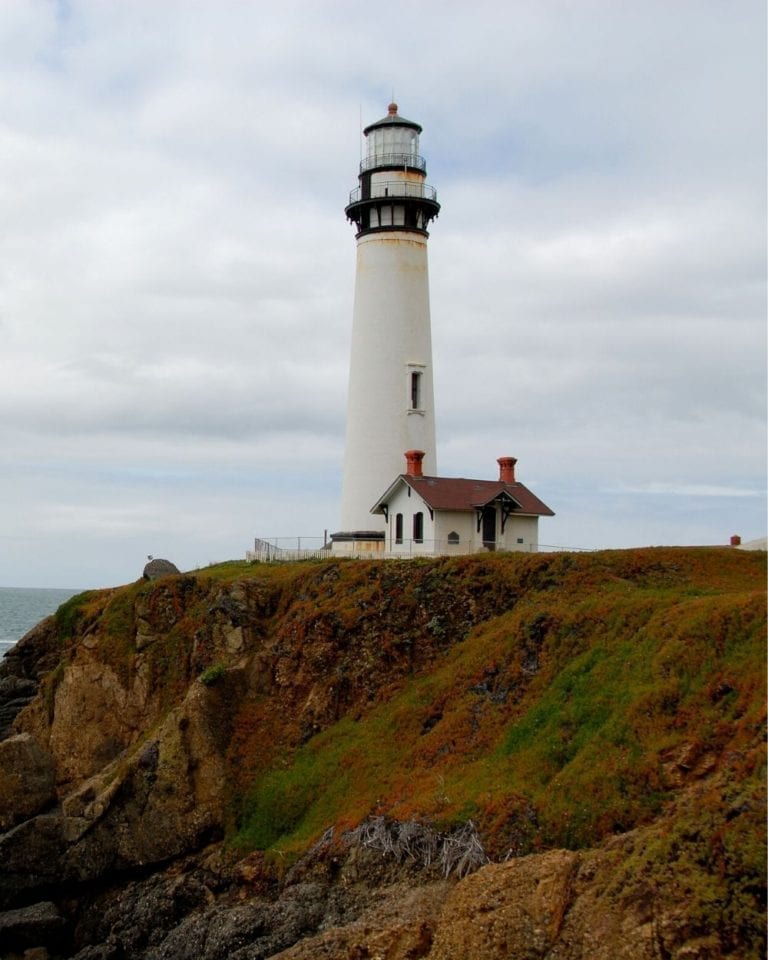
5. Año Nuevo State Park
This Ano Nuevo State Park is famous for its 3-4 mile walk to see elephant seals. During the December to March breeding season, visitors can go on a guided walk bookable through reservecalifornia.com.
For the rest of the year, visitors are required to get a permit from the state park service before making the walk.
As with all state parks in California, you’ll pay the $10 per vehicle entrance fee.
6. Shark Fin Cove
A unique rock formation resembling a shark fin sticking out of the ocean gives this viewpoint its name. Find a spot in the parking lot and take the walk across the train tracks to view the cove from above.
I recommend walking all the way out on the south side of the cove to overlook the ocean. This spot is particularly scenic at sunset.
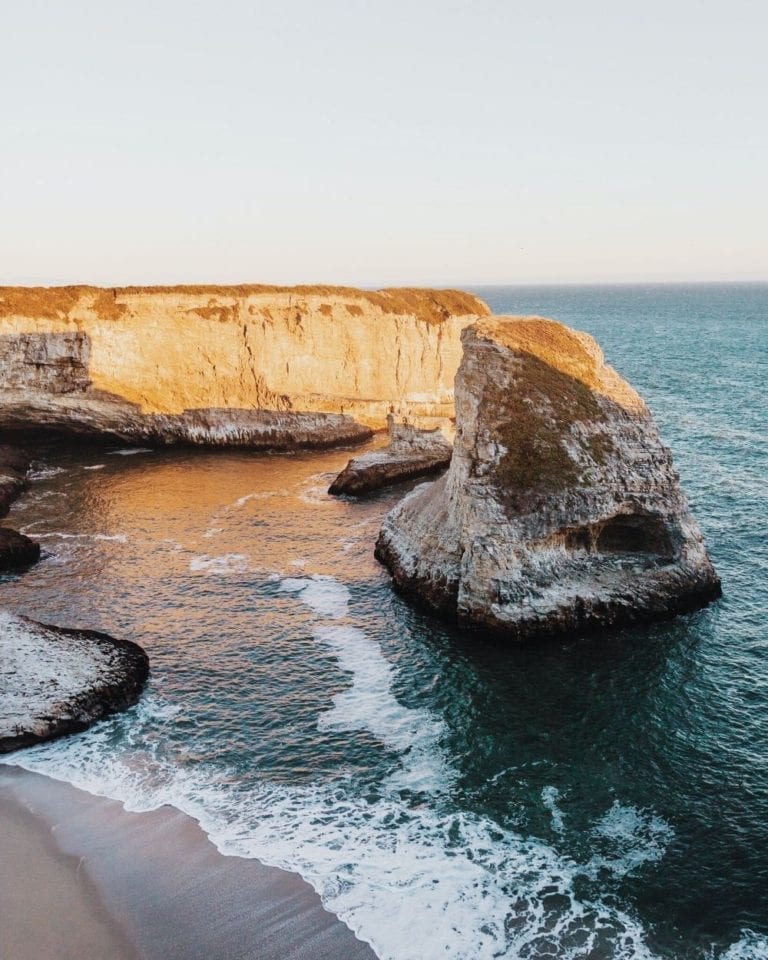
7. Natural Bridges State Park
A type of natural arch, a natural bridge requires a body of water to flow through the archway. These ocean bridges are particularly popular for sunset.
For the $10 park entrance fee, you can park and observe the natural bridges from the state beach.
8. Santa Cruz
The most popular destination in this surfer town is its historic boardwalk. This boardwalk was built in 1904 on the remains of old saltwater bathhouses.
Today, you can ride the 1924 wooden roller coaster or play amusement park games. Park on the Santa Cruz Wharf and walk along Beach Street to the boardwalk.
Be warned, Santa Cruz on a nice summer day is packed. Expect heavy traffic delays.
9. Pezzini Farms
The land between Santa Cruz and Monterey is one of the state’s agricultural hubs. This section of the Pacific Coast Highway is littered with roadside produce stands.
Farms here grow the most brussel sprouts and artichokes in the United States.
Stop at the long-standing Pezzini Farms outpost in Castroville to pick up some fresh artichokes, or even a whole artichoke plant!
10. Monterey
Home to one of the most popular aquariums in the country, Monterey is an old cannery (a facility where food is canned) town.
Walk along the Monterey Bay Coastal Trail to Lover’s Point Park. Grab a bite to eat on Lighthouse Avenue in Pacific Grove.
This is the perfect halfway point to stay the night on your drive to Big Sur.
11. 17 Mile Drive
Passing through the famous Pebble Beach golf course, this scenic drive gets 1.5 million visitors each year. Stop to spot the over 250-year-old famous Lone Cypress.
There are multiple entrances to 17 Mile Drive. I prefer starting at the Pacific Grove gate and exiting at the Carmel gate.
You’ll enter at the gate at the intersection of 17 Mile Drive and Sunset Drive. After paying the $10.50 fee per vehicle, you’ll be given a road trip map to navigate along the scenic drive.
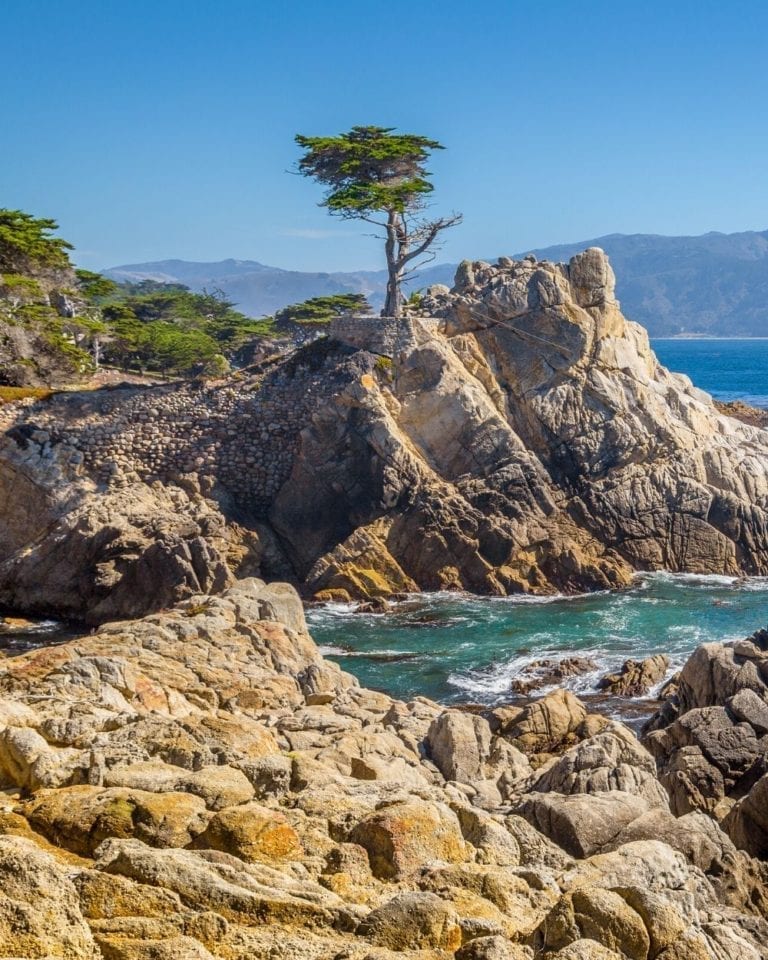
12. Carmel-by-the-Sea
This wealthy beach town is home to some marvelous, and expensive, coastal homes. To see how the 1% live, drive along the oceanfront Scenic Road and gawk at the million-dollar homes.
The main road in Carmel, Ocean Avenue, is filled with boutique coffee shops and restaurants to grab a bite before heading to Big Sur.
Before leaving Carmel-by-the-Sea, make sure you have a full tank of gas.
13. Calla Lily Valley
If you’re visiting in the spring, Calla Lily Valley can’t be missed. This bluff overlooking the ocean is covered with calla lilies during the blooming season.
Stop at the dirt pullout just before the parking lot for Garrapata State Beach. Walk along the bluff to get a closer look at the wildflowers.
14. Bixby Creek Bridge
Perhaps the most recognizable part of the Pacific Coast Highway, Bixby Creek Bridge has been featured in shows like Big Little Lies. It was completed in 1932 and hovers 260 feet above the steep canyon.
For the best view of the bridge, pull over at the Castle Rock Viewpoint before crossing the bridge.
For a vantage point of the bridge against the sea, cross the road (careful of oncoming traffic!) to view from Coast Road.
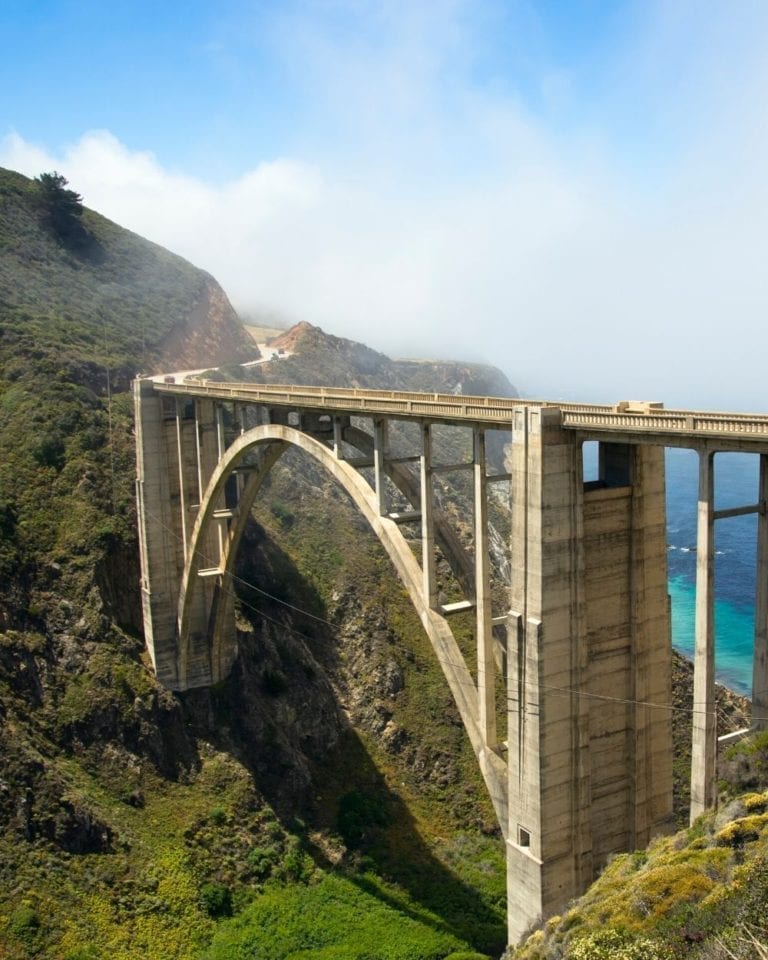
15. Great Sur Turnout
There’s an abundance of turnouts and viewpoints along the Pacific Coast Highway throughout Big Sur. Immediately after a large U-shaped bend in the highway, Great Sur Turnout is one of the best for viewing the jagged coastline.
This turnout also features colorful plant life in the meadow above the beach.
16. Point Sur Lighthouse
This historic site is the only turn-of-the-century lighthouse that remains open to the public in California. Perched atop Point Sur, the lighthouse overlooks the crashing waves below. T
ours of the lighthouse are offered on Wednesdays and weekends for $15. You can also view the supposedly haunted lighthouse on a moonlight tour.
17. Pfeiffer Beach
Popular among locals, this beach is famous for its purple sand, caused by manganese garnet particles. For the $10 state beach entry fee, you can explore the tide pools and the natural arch, known as Keyhole Rock.
The highway cuts inland in this area of Big Sur, so don’t miss the turn onto Sycamore Canyon Road to access Pfeiffer Beach.
18. Julia Pfeiffer Burns State Park
Julia Pfeiffer Burns State Park is one of the most popular parks in Big Sur for hiking and camping. The popular McWay Falls, one of only 7 North American waterfalls that empty into the ocean, can be seen from an overlook off the highway.
Also, consider stopping to hike some of the most popular trails in the area:
- Ewoldsen Trail – a steep 4.5-mile loop trail through a canyon of old redwood growth
- Partington Cove – a steep 1-mile round trip trail through a 60-foot tunnel to view beachfront tide pools
These trails were affected by landslides, so check trail status before hiking.
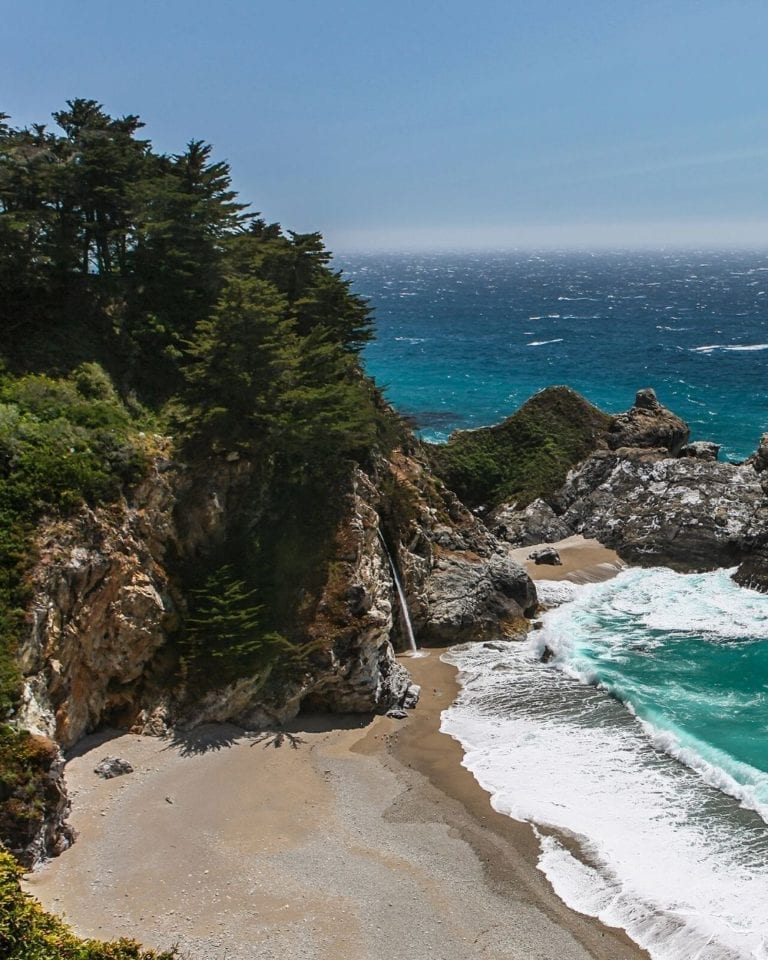
19. Nepenthe and Big Sur Bakery
A popular lunch spot overlooking the ocean, this restaurant has been owned and operated by the same family since founded in 1949. Try the famous ambrosia burger and follow your meal with cookies from Big Sur Bakery.
20. Limekiln State Park
Popular for its secluded beaches and views of the coastline, Limekiln State Park is the perfect leg stretch. The park gets its name from four historic kilns used to harvest limestone from the area in the late 1890s.
Stop to hike the 1.4-mile Limekiln Creek Falls Trail with views of the popular waterfall and old redwoods.
Frequently Asked Questions About This San Francisco to Big Sur Road Trip
How many days do you need in Big Sur?
While you can see the highlights of Big Sur in just one day, I recommend spending at least 2 days in the area. This will give you to the opportunity to stay in the area and see more of the sights.
Where should I stay when driving Big Sur?
The best place to stay when driving Big Sur is in nearby Carmel or Monterrey. These larger towns offer plenty of hotels, motels, and rental homes perfect for those making day trips to Big Sur.
Is Big Sur in between LA and San Francisco?
The Big Sur region is located about halfway between LA and San Francisco. This region in Central California features a rugged coastline and the famed Pacific Coast Highway.
How long does it take to drive the Pacific Coast Highway from San Francisco to LA?
Driving the Pacific Coast Highway from San Francisco to LA takes about 10 to 12 hours without stops. Most visitors choose to spend about 2 to 3 days driving from San Francisco to Los Angeles.
Is driving Big Sur safe?
While there are some risks with driving the narrow, winding Pacific Coast Highway through Big Sur if you practice cautious driving and don’t speed, driving Big Sur is safe.
Is Big Sur worth the drive?
Big Sur is definitely worth the drive! With unparalleled coastal views, scenic mountain hikes, and excellent dining in remote areas, there’s so much to do. This road trip belongs on everyone’s bucket list!
Is the drive to Big Sur scary?
The drive to Big Sur can be scary for those with a fear of heights. Some parts of the scenic drive follow the edge of the cliff. That said, drive cautiously and stop at turnouts and you’ll avoid any dangers.
Final Thoughts on Driving from Big Sur to San Francisco
This guide shares all the scenic stops along the Pacific Coast Highway from San Francisco to Big Sur. While it only takes 4 hours to make this drive straight-through, I recommend taking 2 days and spending a night in Monterey.
Drive the route from north to south to keep the ocean, and turnouts, on your right-hand side. Don’t forget to download Google Maps and all your points of interest before setting out on this scenic drive.
Looking for more adventures along the California Coast? Don’t miss these posts!
- San Francisco to Redwood National Park Road Trip
- The Best California Lost Coast Road Trip
- Hiking Alamere Falls Near San Francisco
Don’t Forget to Save This Post on Pinterest

